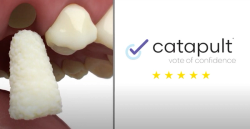- About Us
- Advertise
- Editorial
- Contact Us
- Terms and Conditions
- Privacy Policy
- Do Not Sell My Personal Information
© 2025 MJH Life Sciences™ and Dental Products Report. All rights reserved.
Conservation appreciation
Modern dentistry provides the dental team with many options for restoring the oral cavity. The newer tools like digital impressions, CAD/CAM models and restorations, and full-contour milled restorations, allow us to do many things that were not available in the past.
Modern dentistry provides the dental team with many options for restoring the oral cavity. The newer tools like digital impressions, CAD/CAM models and restorations, and full-contour milled restorations, allow us to do many things that were not available in the past.
However, even with the benefits they can provide, these options should not let us forget what was available in the not-so-distant past. Some of the best dentistry displayed today on the lecture circuit is still done with tried and true PVS impressions and a little ceramic.
When we think of conservative dentistry we tend to think of micro-veneers, however conservative dentistry is conservative in every way. If done properly, dentistry can conserve tooth structure, which builds patient trust and is economically sound.
While many patients still face the problem of over preparation, the following case study can guide the reader through the lab process of a no-preparation restoration.
Case study
The patient presented with a small incisal chip of his lower central incisor (Fig. A). Once the doctor studied the patient’s function to determine if there were any interferences that would translate to the final restoration, a clean polyvinyl impression was taken.
For this no-preparation restoration the refractory veneering technique was applied with GC America’s G-CERA® ORBIT VEST.
01 To create a refractory die for layering, an alveolar model needed to be fabricated (Figs. B and C).
02 To fabricate the working die, the die needed to be cut out of the cast and trimmed with an angled bur so no undercuts were visible (Fig. D).
03 Once the die is inspected for undercuts it should be fixed back into the original impression where a check is made that the die is angled the way a natural root is angled, and that once again no undercuts are visible (Fig. E).
04 To aid in the release of the die, once stone is poured into the cast, a thin layer of clear wax is applied to the “root” of the fixed die. The model is then poured with a type 4 stone-GC Fuji-Rock was used in this case-and left to set for its proper setting time.
05 The die then is tapped out of the master alveolar cast, and it is imperative to check that the alveolar die is fixed in the exact position as it is in the solid cast. A matrix taken of the solid cast is transferred to the alveolar cast to check the precision of this position (Fig. F).
06 Once this is checked, the master alveolar die (Alpha Die) will have spacer applied to the area where ceramic will be built and duplicated. Once duplicated, G-CERA® ORBIT VEST refractory material was poured and put under pressure until set (Fig. G).
07 With everything checked the ceramic now can be layered. The first step is to seal the refractory material. This is done by firing a clear layer of GC America’s GC Initial CL-O on the working area at a high firing cycle, 20° higher than the first dentin cycle (Fig. H).
08 Once sealed the layering can take place. A light mamelon is built (Fd91/A1) at the incisal followed by an enamel overlay (E-58/Eop-3). This is fired at 910°C.
09 Once fired, the restoration is treated with rotary instruments for surface texture and detail. It is then glazed (Fig. I).
10 After glazing and polishing, the veneer is ready for divesting. To divest, the refractory material is cut away from the margin areas with Brasseler USA’s DiaLites™, and the root portion of the die is cut off.
Once cut, the veneer is embedded in a small, thin putty matrix and lightly sandblasted at low pressure until the refractory material is no longer present in the veneer (Fig. J).
12 Divested, one can see just how thin and fragile the conservative veneer is (Fig. K). The veneer is then etched and treated like a traditional veneer and brought to the mouth for insertion.
13 At insert a fixed stick can aid to guide the fragile restoration into place (Fig. L).
14 Once the veneer is bonded, the finish line can be taken down intraorally with DiaLites and silicone burs. The goal is to blend the finish line into the natural dentition for a nice final result (Fig. M).
Conclusion
Through the use of this veneering technique one can see that a nice value match is achieved by using the natural dentition as our underlying color (Fig. N). By inverting the final image one also can see that we achieved a nice result in form by using the natural dentition as our guide (Fig O).
With this conservative approach the dental team can restore teeth back to a natural state with no needles, pain or discomfort, reaching a great final result (Fig. P).
About the author
Joshua Polansky earned his Bachelor of Arts degree, Summa Cum Laude, from Rutgers University in 2004. While working part time at a dental laboratory, he took advantage of an opportunity to apprentice with distinguished master technician, Olivier Tric of Oral Design Chicago. Mr. Tric opened Joshua’s eyes to a whole new world of possibilities. He continued to acquire technical skills by studying in Europe with other mentors and experts in the field such as Klaus Mutertheis. Joshua earned his Master’s degree in dental ceramics at the UCLA Center for Esthetic Dentistry under Dr. Edward McLaren. Joshua continued his training under Jungo Endo and Hiroaki Okabe at UCLA’s advanced prosthodontics and maxillofacial program working on faculty and residents’ cases. He currently resides in Cherry Hill, N.J., where he is the owner and operator of Niche Dental Studio.



